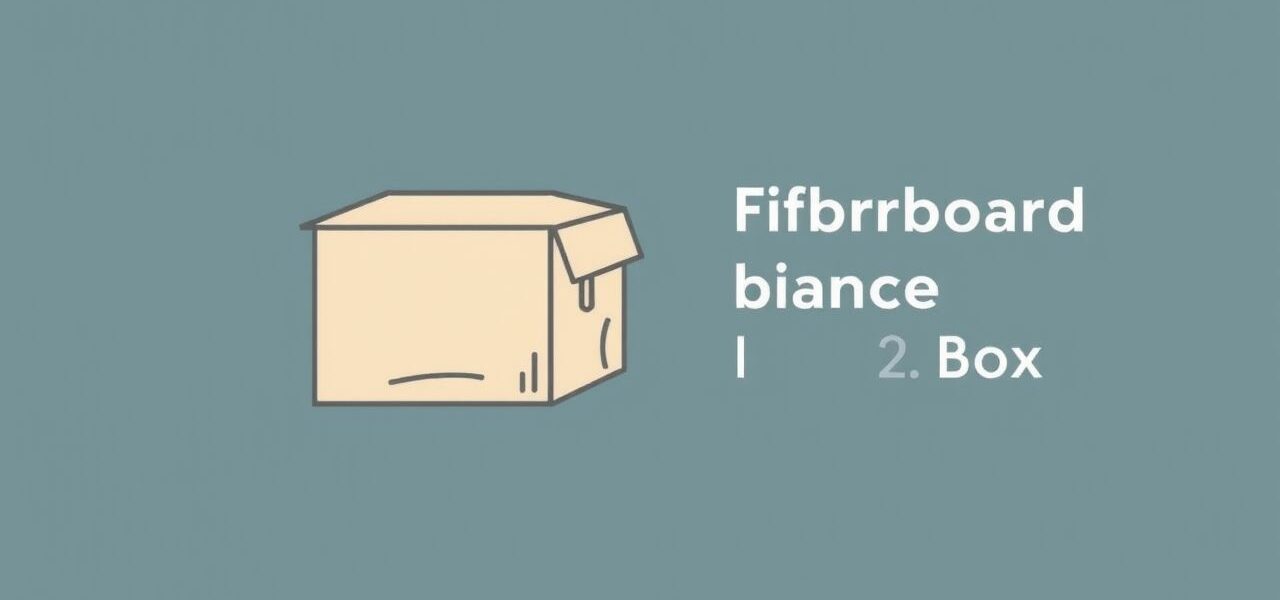Fiberboard boxes are one of the most commonly used packaging solutions in the world, found in homes, offices, factories, and shipping centers. These boxes offer a lightweight yet durable way to store and transport goods of all kinds. Whether used for moving household items, packaging electronics, or shipping food products, fiberboard boxes serve an essential role in logistics and storage. Their affordability, recyclability, and strength make them a preferred choice for businesses and individuals alike.
Definition of a Fiberboard Box
A fiberboard box is a container made from compressed wood fibers or paper pulp. It is a type of paper-based material that is formed into sheets and then shaped into boxes or cartons. The most common form of fiberboard used in packaging is corrugated fiberboard, which includes a fluted sheet sandwiched between two flat linerboards. These boxes are also known as corrugated boxes or cardboard boxes.
Types of Fiberboard
Fiberboard boxes come in various types based on the material’s thickness and construction. The most popular include:
- Corrugated Fiberboard: Known for its fluted middle layer, this type provides cushioning and strength for shipping and handling.
- Solid Fiberboard: A denser material without flutes, commonly used for smaller boxes and applications that require a smooth surface.
- Single-Wall, Double-Wall, and Triple-Wall: These terms refer to the number of corrugated layers used in construction. The more layers, the stronger the box.
Materials Used in Fiberboard Boxes
The primary raw material for fiberboard is wood pulp, which is often recycled paper. This makes the production process environmentally friendly and cost-effective. Some boxes use a mix of virgin and recycled pulp to balance durability and sustainability. Adhesives and coatings may be added to enhance moisture resistance or to improve printing surfaces.
Recyclable and Eco-Friendly
Fiberboard is widely recyclable and biodegradable, making it a responsible choice for packaging. Many companies opt for fiberboard packaging to reduce plastic usage and align with eco-conscious goals.
Common Uses of Fiberboard Boxes
Fiberboard boxes are used in countless industries and settings. Their adaptability and protective qualities make them suitable for transporting everything from fragile glassware to heavy machinery components.
Packaging and Shipping
- Electronics and appliances
- Food and beverages
- Retail products
- Automotive parts
- Clothing and textiles
Storage and Organization
In homes and offices, fiberboard boxes are often used to organize paperwork, archive documents, or store personal belongings. They are easy to label, stack, and move around, which makes them a practical choice for both short- and long-term storage.
Benefits of Using Fiberboard Boxes
Fiberboard boxes offer several advantages that contribute to their widespread popularity in packaging and shipping. These benefits include strength, cost-efficiency, customizability, and environmental friendliness.
Strength and Durability
Corrugated fiberboard can absorb shock and protect contents from damage during transport. Its design distributes weight evenly and can resist crushing under pressure. The number of layers and the quality of the fluting influence the overall durability of the box.
Lightweight and Cost-Effective
Despite being strong, fiberboard boxes are relatively lightweight, which helps reduce shipping costs. They are also inexpensive to manufacture and purchase in bulk, making them ideal for businesses of all sizes.
Customizable Sizes and Prints
Fiberboard boxes can be easily cut, folded, and glued into different sizes and shapes. They can also be printed with company logos, barcodes, handling instructions, or branding. This makes them a useful tool for marketing as well as logistics.
Environmentally Sustainable
Many fiberboard boxes are made from recycled content and can be reused multiple times before being recycled again. This helps reduce landfill waste and encourages responsible consumption.
Limitations of Fiberboard Boxes
While fiberboard boxes are useful in many scenarios, they do have some limitations. Understanding these helps users choose the right type of packaging for specific needs.
- Moisture Sensitivity: Fiberboard can weaken or warp when exposed to water or high humidity unless treated or coated.
- Limited Security: These boxes can be easily opened or damaged without added seals or reinforcement.
- Not Ideal for Long-Term Heavy Loads: Over time, fiberboard may lose strength when storing very heavy items, especially if stacked improperly.
Choosing the Right Fiberboard Box
To select the best fiberboard box, consider the weight and nature of the contents, shipping conditions, and storage environment. Knowing whether you need a single-wall box for lightweight goods or a triple-wall box for industrial items will ensure safe and efficient transport.
Key Factors to Consider
- Size and dimensions
- Number of walls (single, double, triple)
- Type of contents (fragile, heavy, perishable)
- Exposure to moisture or extreme temperatures
- Need for custom printing or branding
How Fiberboard Boxes Are Made
The production of fiberboard boxes involves several steps, starting from pulp processing to cutting and folding the final box. Here’s a simplified overview:
- Wood or recycled paper is turned into pulp
- Pulp is pressed into sheets and dried
- Corrugated fluting is created and sandwiched between linerboards
- The corrugated fiberboard is cut into box templates
- Templates are folded, glued, and assembled into finished boxes
Advanced machinery is often used to ensure precision and speed in the manufacturing process. Quality control checks are also conducted to ensure the boxes meet industry standards for strength and reliability.
Applications in Modern Industry
Today, fiberboard boxes are a staple in global supply chains. From e-commerce warehouses to grocery delivery services, these boxes make product movement safer and more efficient. They are also being adapted to new technologies such as smart labels, RFID tracking, and eco-friendly coatings, which continue to improve their performance and sustainability.
A Versatile Packaging Solution
A fiberboard box is more than just a container it is a reliable, economical, and eco-conscious packaging solution. Whether used in shipping, retail, or storage, fiberboard boxes offer strength, versatility, and convenience. By understanding their composition, types, and uses, individuals and businesses can make better decisions that protect their products and support sustainable practices. As industries evolve and demand smarter packaging options, fiberboard remains a trusted choice for efficient and responsible packaging.
